sierraclub.org - sierra magazine - September/October 2009 - enjoy


Enjoy | The Green Life
By Avital Binshtock
Serious Cereal | Trendsetter | Last Straw | Spamming the Globe | Gnarly Baubles
The Chronic Misperception of Hemp | Green Biz | Grapevine
Serious Cereal
Confused by the recent explosion of Earth-friendly breakfast options? We did the chewing for you.
Cereal, that most beloved of breakfast (and lunch, and dinner, and late-night snack) foods, has gone green. For those shoppers facing the ever-growing array of eco-conscious cereal brands lining supermarket shelves, Sierra Club staffers valiantly agreed to blind-taste more than 25 varieties in our effort to help you sift the savory wheat from the inedible chaff.
The winners, below, were drenched in compliments. The losers, which shall remain unnamed, suffered the verbal equivalent of getting dumped in the compost bin: "like eating socks," "dis-freaking-gusting," "tastes like sunscreen," "looks like sawdust," "cloying," and "Styrofoam."
To qualify for the tasting, a cereal had to be certifiably planet-friendly, whether organic, made with solar power, or produced by a company that donates to environmental causes. We limited the choices to cold cereals and let our 14 tasters opt for low-fat cow's milk or soy milk. They rated each cereal on a 1-to-10 scale, and we averaged their scores to determine our winners.
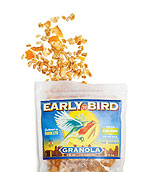

Score: 7.8 | $8 for 12 oz. | earlybirdfoods.com
This "not too sweet" granola with a "bright and lovely" appearance reminded one person of Christmas, another of Cracker Jack. Most agreed that it has a "good balance between crunch and fruit" and that it "holds up well to milk." Though it was "too buttery" for one and "too chewy" for another (and, we'd imagine, too expensive for many), it's a "wholesome," "fresh-tasting" delight flecked with coconut, macadamia, and tangy dried fruit. Early Bird owner Nekisia Davis says she buys organic ingredients whenever possible, recycles and composts all waste, and uses rice-paper packages that biodegrade faster than plastic.
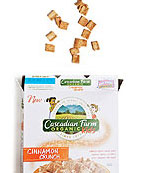

Score: 6.8 | $3.99 for 13.25 oz. | cascadianfarm.com
"Cinnamon Toast Crunch? Or at least a good imitation," mused one taster. Another described it as tasting "like childhood," though a few complained of too much sugar. Tasters also gave high marks to Cascadian Farm's Dark Chocolate Almond Granola, which was called "lightly sweet" with a "good, nutty flavor." Cascadian Farm, now a General Mills brand, has been organic for more than 35 years and doesn't use synthetic pesticides, herbicides, or GMOs to grow its ingredients.
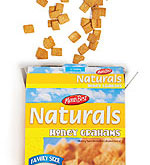

Score: 6.4 | About $3 for 17.5 oz. | momsbestnaturals.com
"If you poured milk into a box of graham crackers, you'd taste this cereal" was the enthusiastic conclusion about this one. "Great for the young," one opined, while another swooned, "Love these tiny, delicious morsels." "A little one-dimensional," said a naysayer. People were also fans of the brand's Honey Nut Toasty O's, said to be the "simple yet satisfying" "cousins to Cheerios." Mom's Best's boxes are made of 100 percent recycled paperboard. Its facilities are wind-powered, and the family-owned company recycles almost all its waste.
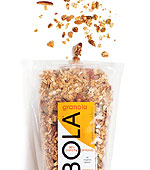

Score: 6 | About $7 for 16 oz. | bolagranola.com
Tasters were "pleasantly surprised" by this "earthy," "salty" cereal that "looks like birdseed" but has a "good range of ingredients"—almonds, oats, nuts, and seeds—and a "wholesome sweetness." One rater said that it "tastes like a forest," while another noted that it's "more like trail mix than cereal. A winner."
Owner Michele Miller handcrafts her granolas with all-organic grains in Massachusetts's Berkshires and distributes them locally using what she calls "a veggie-powered truck."
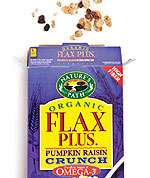

Score: 6 | About $5 for 12.35 oz. | naturespath.com
TThis one "tastes like Raisin Bran but more wholesome." The flakes "don't soften up in milk" and are "not too sweet," resulting in a "nicely balanced cereal" with "raisins, nuts, and granola." A few thought it was "nothing special" but "improved with milk." Nature's Path buys farmland and converts it to be organic, has reduced the amount of paper in its packages, has installed a green roof on its headquarters, and was named by Maclean's magazine this year as one of Canada's greenest employers. The company also donates to conservation nonprofits.
Trendsetter
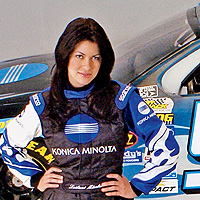
Leilani Muenter, auto racer and environmental activistThink the term "NASCAR environmentalist" is an oxymoron? Guess again. Leilani Münter, 33, one of Sports Illustrated's top-ten female race car drivers, is an unabashed eco-warrior. A passionate ambassador for the National Wildlife Federation, she has lobbied Congress to pass the Climate Security Act, makes frequent appearances to educate fans about going green, and buys an acre of rainforest for every race she runs. She took time out of her high-speed schedule to chat with Sierra.
Q: How do you reconcile your car-racing with your environmentalism?
A: I'm not going to apologize for liking fast cars. I have a much bigger voice because of it. If I stop racing, there'll be someone else in that seat. I wouldn't have a platform to reach 100 million people. I was in Norway at the zero-emissions Viking Rally driving a hydrogen fuel cell Ford Focus. When I got out of the car, I drank the water from my exhaust pipe to show how clean it was.
Q: As a conservationist, what are you proudest of?
A: I don't know if conservation is something that lends itself to being proud. My role is that I can speak to a large group of people. If I can highlight the small things we can do, like recycling or eating less meat, those small changes multiplied by millions of race fans could make a gigantic difference.
Q: How do people in the racing world respond to environmental advocacy?
A: It's been very positive lately. When I first started talking about it, people told me I was committing career suicide, that I would push away sponsors. But if a company doesn't want to work with me because I talk about the environment, those aren't people I want on my car anyway.
Q: What are you proudest of in your racing career?
A: The fact that I'm using my voice in the sport to emphasize that are things that are important outside the car. But I am proud of my finish at Texas and of how I did when I ran in the Indy Lite race. I qualified fifth, even though I ended up in a wreck. It earned me respect from the higher-ups in my sport.
Q: How did you decide to be a vegetarian?
A: When I was six, my mom went vegetarian, and then the whole house did. I was at a Wendy's with my mom. I didn't realize what meat was, and then she explained it to me. It was so traumatic that I can remember it like it was yesterday. I was horrified when I found out that I was biting into the side of a cow. I don't think it's my right to take life. We're in different bodies, but we're all sharing the same earth.
Now I always talk about how the meat industry emits more greenhouse gas than the whole transportation industry combined. And that methane is 21 times more heat-trapping than carbon dioxide, and that it lasts in the atmosphere much longer. If Americans alone were to cut back their meat consumption 10 percent, it would free up enough land for us to grow grain for all the hungry kids in the world. All people have to do is make the connection between what's on their plate and the environment.
Q: Do you know any other race car drivers who are vegetarian?
A: One other, who wrote to me to ask about racing shoes that weren't made of leather. It's a small population, but they're out there. I've heard of a couple others.
Q: How else do you live green?
A: My husband and I bought an Energy Star&endash;certified house. When we were shopping for a house, we agreed that we didn't want to move anywhere that wasn't energy-efficient, with solar lighting, a composter, a vegetable garden, and so on. We're getting a solar water heater, we're big recyclers, we unplug, we just do what we can to make our impact as little as possible.
Q: Last year you spoke to Congress about climate issues. What was that like?
A: I'd never been to Congress or really spent time in D.C. I was taking the next step with my activism, taking it to the political level to make it law, to make corporations liable. For me, it was exciting to see this whole other side of the environmental movement. That's where a lot of the changes are going to take place&emdash; in D.C.
Q: How can auto racing--and its fans--go green? How likely do you think that is?
A: I use my race car to reach out to fans on environmental issues. My sponsor is Smart Paper. I want a lightbulb on the hood of my car. When I get out of my car, I want to be able to say if each one of the 100,000 Daytona fans here today were to make the switch, this would be the impact. But I can't do it until corporate America says yes, this makes sense. I need their support or else I can't do it. These are 100 million people that environmentalists need to talk to in order to get movement.
There's constant innovation happening in racing. It can be the difference between winning and losing the Daytona 500 to be fuel-efficient. It can be the difference between millions and millions of dollars. They could use it as a testing ground for new green technologies.
On the Web Learn more about Münter at leilanimunter.com.
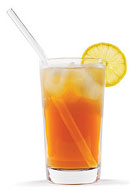 Last Straw
Last Straw
If you're worried about the plastic continent that is the Great Pacific Garbage Patch, you might give a second thought to single-use straws. David Leonhardt, a glassblower by trade and an environmentalist by persuasion, did, and the result is a dishwasher-safe glass straw. His company, Glass Dharma, offers them for about $7 each in straight, bent, and bejeweled versions, as well as hemp or bamboo protective sheaths. Made of borosilicate, the strongest commercially available glass, the straws are sturdier than they appear. And if one does break, Leonhardt will replace it for free. Those who'd prefer stainless-steel tubes can buy four for $9 at AlwaysBrilliant.com.
Spamming the Globe
 Until now, we've thought of spam as virtual pollution. It turns out that all those annoying e-mails blight not only our in-boxes but also the atmosphere. According to a report by McAfee, maker of spam-blocking software, 62 trillion junk e-mails were received worldwide in 2008.
All those male-enhancement testimonials and Nigerian investment opportunities wasted enough electricity to power 2.4 million U.S. homes for a year. The three seconds it takes to review and delete a spam message emits a 0.3-gram puff of carbon dioxide—equal to driving a car three feet. Americans collectively spend 100 billion aggravating hours per year shedding unwanted e-mails.
Until now, we've thought of spam as virtual pollution. It turns out that all those annoying e-mails blight not only our in-boxes but also the atmosphere. According to a report by McAfee, maker of spam-blocking software, 62 trillion junk e-mails were received worldwide in 2008.
All those male-enhancement testimonials and Nigerian investment opportunities wasted enough electricity to power 2.4 million U.S. homes for a year. The three seconds it takes to review and delete a spam message emits a 0.3-gram puff of carbon dioxide—equal to driving a car three feet. Americans collectively spend 100 billion aggravating hours per year shedding unwanted e-mails.
Gnarly Baubles
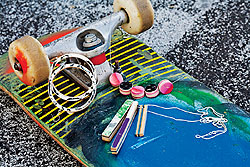 Skateboards are known for their vivid graphics, so it's a shame that these street-scarred slabs end up beaten and broken. Or is it? Skate-culture craftspeople are transforming scavenged decks into one-of-a-kind belt buckles, pocket mirrors, key chains, bags, money clips, and jewelry. One company, Seven Ply (sevenplydesigns.com; named for a skateboard's heptad layers), hawks its handmade trinkets with the motto "Turning thrash'n into fashion." Artisans like 2ReVert, Beck(y), and MapleXO peddle pieces just as alt-chic and candy-colorful.
Skateboards are known for their vivid graphics, so it's a shame that these street-scarred slabs end up beaten and broken. Or is it? Skate-culture craftspeople are transforming scavenged decks into one-of-a-kind belt buckles, pocket mirrors, key chains, bags, money clips, and jewelry. One company, Seven Ply (sevenplydesigns.com; named for a skateboard's heptad layers), hawks its handmade trinkets with the motto "Turning thrash'n into fashion." Artisans like 2ReVert, Beck(y), and MapleXO peddle pieces just as alt-chic and candy-colorful.
The Chronic Misperception of Hemp
Hemp needs to go to rehab for its image problem. It's tied in most people's minds to marijuana (a different strain of plant), but if you tried to smoke it, you wouldn't feel any higher than the ground it grows on. Which is pretty clean, since hemp needs no pesticides, grows back quickly, and preserves soil better than cotton does.
The stuff is woven into U.S. history: Betsy Ross made flags from it, George Washington farmed it, and the Declaration of Independence and the Constitution were reportedly drafted on it.
So why is it now illegal to cultivate in the United States? The story goes that William Randolph Hearst, who owned forests, lobbied heavily and ran articles to link hemp to marijuana use. The campaign worked, hemp agriculture was outlawed, Hearst's forests were turned into paper, and he got even richer.

Hemp fashion from Viridis Luxe.Hemp's demonized status in the United States has been a boon for Canada, now a global leader in the plant's production. Though more than half our states are trying to legalize industrial hemp, a move that would create thousands of jobs, its cultivation remains a punishable offense.
If a domestic demand develops for harmless, high-quality hemp products like the ones here, the crop may one day return to its place on U.S. farmland. —Avital Binshtock
On the Web For more information, go to votehemp.com.
Viridis Luxe makes high-end hemp-wear that feels like fine, thin cashmere. Knit with an eye for detail and originality, these pieces are chic enough that Jennifer Aniston and Rachel Bilson wear them, but they also provide a flattering fit for the average tree-hugger. Starting at around $110; viridisluxe.com
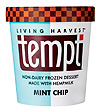 Tempt, a fro-yo-like dessert made of "hemp-milk" by Living Harvest Foods, comes in five varieties, like coconut lime and coffee biscotti. It takes a bit longer to soften than "normal" ice cream, but the flavors, tinged with a pleasant nuttiness, are enjoyable. Hemp foods are nutritious, thanks to lots of fatty acids, protein, fiber, vitamins, and minerals. $4.69; livingharvest.com
Tempt, a fro-yo-like dessert made of "hemp-milk" by Living Harvest Foods, comes in five varieties, like coconut lime and coffee biscotti. It takes a bit longer to soften than "normal" ice cream, but the flavors, tinged with a pleasant nuttiness, are enjoyable. Hemp foods are nutritious, thanks to lots of fatty acids, protein, fiber, vitamins, and minerals. $4.69; livingharvest.com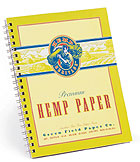
Hemp paper is different from wood paper in that it requires less processing, can be whitened without emitting dioxins, and doesn't yellow over the years. Green Field Paper Company sells an attractive selection of hemp-based journals, sketchbooks, cards, and stationery, many with delicate nature-inspired patterns, and much of it handcrafted. $16 for the sketchbook pictured; greenfieldpaper.com
Green Biz
Living consumptively is losing popularity but remains a hard habit to quit. "Most people would like to go green but haven't made it a priority," says Rosamaria Caballero, cofounder of eco-consulting firm Green Irene. She and other entrepreneurs are making it their job to help clients lead more sustainable lives.
Green-living coaches' services vary. Anca Novacovici, founder of Washington, D.C.-based Eco-Coach, performs home or business "eco-audits" that analyze consumption and product use, then recommends specific changes, like buying natural personal-care products, installing efficient showerheads, and minimizing "vampire energy" wasted by appliances in standby mode.
Cristen Jester, owner of Organic Happiness, focuses on motivation. "Eco-coaching to me is more about reconnecting people with nature," she says—something she accomplishes through guided hikes, gardening, and other outdoor exercises. "As they begin to feel that connection, they want to take green steps in their lives and in their homes."
Organic Happiness sessions start at $70, Green Irene home makeovers are $99, and Eco-Coach audits begin at $200. —Jamie Hansen
Grapevine
L.A. mayor Antonio Villaraigosa declared that by 2020 his city will no longer be powered by coal. | Two male penguins that were given a fertilized egg have hatched a chick and are raising it together. | Train travel may be as bad as airplane travel on the environment. | The U.S. Postal Service is replacing about 6,500 cars from its current fleet with greener vehicles. | Bundanoon, Australia, has banned bottled water.
Photos and illustrations, from top: Lori Eanes (5), Phil Cavali/Konica Minolta, Lori Eanes, Josef Gast, Lori Eanes, Andrea Radoutou, courtesy of Living Harvest Foods, Lori Eanes; used with permission
This article has been corrected subsequent to publication.